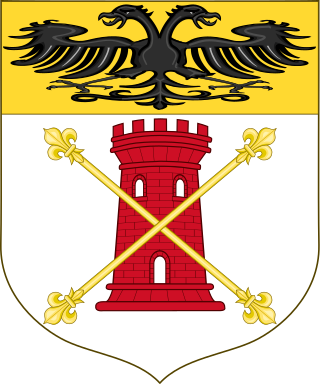
The Lord of Milan was a medieval noble title for the dynastic head of state of the city of Milan and surrounding countryside in northern Italy. From 1277 to 1395, the Visconti family held the title, after which they were elevated to Duke of Milan.
Until 1259, Milan was a free commune that elected its own podestà . The Torriani family gained sustained power in 1240, when Pagano della Torre was elected podestà. [1] After Pagano's death, Baldo Ghiringhelli was elected podestà in 1259, but at the end of his tenure Martino della Torre, Pagano's nephew, perpetrated a coup d'état, seizing power for his family and establishing the first Signoria ('Lordship') of Milan. [2]
| Signore | Rule | Affiliation | Podestà(s) | |
|---|---|---|---|---|
| Martino della Torre | 8 September 1259 | 20 November 1263 | Guelph | Captain general: List
|
| Filippo della Torre | 20 November 1263 | 24 December 1265 | Guelph | List
|
| Napoleone della Torre | 24 December 1265 | 21 January 1277 | Guelph | List
|
During their tenure, the Torriani family, aligned with the French Charles of Anjou (the Guelph faction), began a strong rivalry with the Visconti family, who were aligned with the German Hohenstaufen (the Ghibelline faction). [3] In 1262, Pope Urban IV appointed Ottone Visconti as Archbishop of Milan, to Martino della Torre's disappointment. [4] In 1273, a civil war started between the two families, ending with the Torriani's defeat in the Battle of Desio of 1277, which the Visconti subsequently commemorated with frescoes in the Castle of Angera. [5]
| Signore | Rule | Affiliation | Podestà(s) | |
|---|---|---|---|---|
| Ottone Visconti | 21 January 1277 | 8 August 1295 | Ghibelline | Captain general:
List
|
| Matteo I Visconti | 8 August 1295 | June 1302 | Ghibelline | List
|
In June 1302, Guido della Torre forged a coalition with anti-Visconti cities and marched on Milan, deposing the Visconti. [6] However, in 1308 Guido quarrelled with his cousin, the Archbishop Cassone della Torre. After an assault on Milan Cathedral, Cassone fled to Bologna and solicited an imperial intervention. [7] Taking advantage of a chaotic situation in Northern Italy, King Henry VII of Germany invaded Italy, and in Autumn 1310 he marched on Milan to restore both Cassone and the Visconti. After the fall of Milan, he was crowned King of Italy in the city's Cathedral. [8]
| Signore | Rule | Affiliation | Podestà(s) | |
|---|---|---|---|---|
| Guido della Torre | June 1302 | 6 January 1311 | Guelph | List
|
| Matteo I Visconti | 6 January 1311 | 24 June 1322 | Ghibelline | List
|
| Galeazzo I Visconti | 24 June 1322 | 6 August 1328 | Ghibelline | List
|
| Azzone Visconti | 6 August 1328 | 16 August 1339 | Ghibelline | List
|
| Luchino Visconti | 16 August 1339 | 24 January 1349 | Ghibelline | List
|
| Giovanni Visconti | 5 October 1354 | |||
| Matteo II Visconti | 5 October 1354 | 29 September 1355 | Ghibelline | List
|
| Galeazzo II Visconti | 4 August 1378 | |||
| Bernabò Visconti | 6 May 1385 | |||
| Gian Galeazzo Visconti | 6 May 1385 | 5 September 1395 | Ghibelline | List
|













